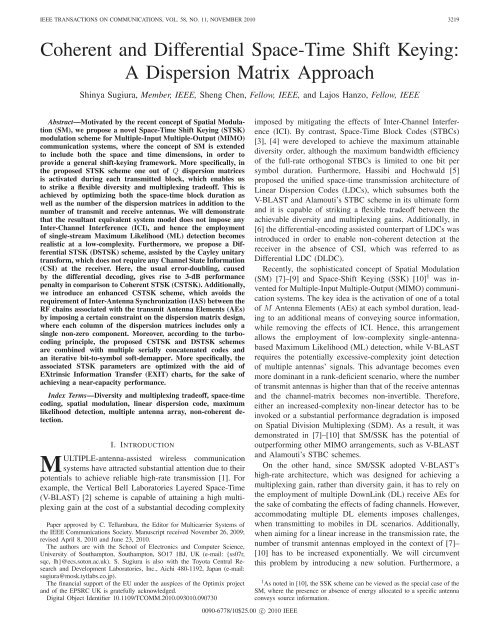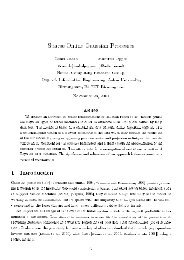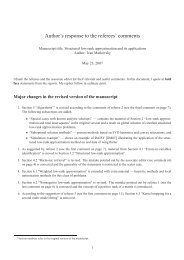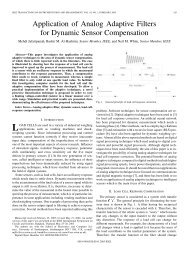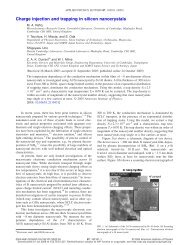Coherent and Differential Space-Time Shift Keying - ECS EPrints ...
Coherent and Differential Space-Time Shift Keying - ECS EPrints ...
Coherent and Differential Space-Time Shift Keying - ECS EPrints ...
You also want an ePaper? Increase the reach of your titles
YUMPU automatically turns print PDFs into web optimized ePapers that Google loves.
IEEE TRANSACTIONS ON COMMUNICATIONS, VOL. 58, NO. 11, NOVEMBER 2010 3219<br />
<strong>Coherent</strong> <strong>and</strong> <strong>Differential</strong> <strong>Space</strong>-<strong>Time</strong> <strong>Shift</strong> <strong>Keying</strong>:<br />
A Dispersion Matrix Approach<br />
Shinya Sugiura, Member, IEEE, Sheng Chen, Fellow, IEEE, <strong>and</strong> Lajos Hanzo, Fellow, IEEE<br />
Abstract—Motivated by the recent concept of Spatial Modulation<br />
(SM), we propose a novel <strong>Space</strong>-<strong>Time</strong> <strong>Shift</strong> <strong>Keying</strong> (STSK)<br />
modulation scheme for Multiple-Input Multiple-Output (MIMO)<br />
communication systems, where the concept of SM is extended<br />
to include both the space <strong>and</strong> time dimensions, in order to<br />
provide a general shift-keying framework. More specifically, in<br />
the proposed STSK scheme one out of
3220 IEEE TRANSACTIONS ON COMMUNICATIONS, VOL. 58, NO. 11, NOVEMBER 2010<br />
coherently detected SM/SSK scheme requires Channel State<br />
Information (CSI) at the receiver, although it is a challenging<br />
task to acquire accurate CSI for high-speed vehicles, which<br />
may require a high pilot overhead <strong>and</strong> imposes a substantial<br />
processing complexity. The resultant CSI estimation error is<br />
expected to erode the achievable performance.<br />
Against this background the novel contributions of this<br />
paper are as follows:<br />
1) Inspired by the SM/SSK scheme, we propose the novel<br />
concept of <strong>Space</strong>-<strong>Time</strong> <strong>Shift</strong> <strong>Keying</strong> (STSK) modulation,<br />
which constitutes a generalized shift-keying architecture<br />
utilizing both the space as well as time dimensions<br />
<strong>and</strong> hence includes the SM <strong>and</strong> SSK schemes<br />
as special cases. More specifically, the STSK scheme<br />
is based on the activation of
SUGIURA et al.: COHERENT AND DIFFERENTIAL SPACE-TIME SHIFT KEYING: A DISPERSION MATRIX APPROACH 3221<br />
TABLE I<br />
EXAMPLE OF STSK MODULATION SCHEME,MAPPING 3BITS PER SPACE-TIME BLOCK, WITH THE AID OF L–PSK CONSTELLATION
3222 IEEE TRANSACTIONS ON COMMUNICATIONS, VOL. 58, NO. 11, NOVEMBER 2010
SUGIURA et al.: COHERENT AND DIFFERENTIAL SPACE-TIME SHIFT KEYING: A DISPERSION MATRIX APPROACH 3223<br />
Source<br />
S/P<br />
Fig. 2. Transmitter structure of our DSTSK scheme.<br />
DSTSK block<br />
D. Computational Complexity<br />
Let us now characterize the computational complexity imposed<br />
by the ML detection of our CSTSK scheme for both<br />
rapid <strong>and</strong> slow fading, which are given, respectively, by<br />
⎧
3224 IEEE TRANSACTIONS ON COMMUNICATIONS, VOL. 58, NO. 11, NOVEMBER 2010<br />
III. THREE-STAGE CONCATENATED TURBO STSK<br />
SCHEME<br />
Let us invoke the turbo principle [12] to incorporate the<br />
proposed CSTSK <strong>and</strong> DSTSK schemes of Section II in a<br />
multiple-stage serially concatenated arrangement, for the sake<br />
of achieving a near-capacity performance. Furthermore, the<br />
iterative soft demapping principle is derived for our STSK<br />
scheme. Additionally, the capacity of our CSTSK scheme is<br />
also characterized.<br />
A. System Overview<br />
Fig. 3 shows the schematic of the proposed three-stage<br />
channel- <strong>and</strong> Unity Rate-Coded (URC) STSK scheme using<br />
iterative detection. Here, the input source bits are channelencoded<br />
by a half-rate Recursive Systematic Convolutional<br />
(RSC) code <strong>and</strong> are interleaved by a r<strong>and</strong>om bit interleaver Π1.<br />
Then, the interleaved bits are further encoded by a recursive<br />
URC encoder [16] 5 , <strong>and</strong> then the coded bits are interleaved<br />
by the second r<strong>and</strong>om interleaver Π2 of Fig. 3. Finally, the<br />
interleaved bits are input to the CSTSK block of Fig. 1 or<br />
DSTSK block of Fig. 2, followed by the transmission of the<br />
space-time block
SUGIURA et al.: COHERENT AND DIFFERENTIAL SPACE-TIME SHIFT KEYING: A DISPERSION MATRIX APPROACH 3225<br />
Source<br />
Outer code Inner code<br />
Channel<br />
encoder<br />
Channel<br />
decoder<br />
Unity-rate<br />
encoder<br />
Unity-rate<br />
decoder<br />
CSTSK<br />
/DSTSK<br />
block<br />
CSTSK<br />
/DSTSK<br />
demapper<br />
<strong>Space</strong>-time<br />
1<br />
<br />
mapper<br />
Fig. 3. Schematic of a three-stage RSC- <strong>and</strong> URC-coded coherent or differential STSK scheme using iterative detection.<br />
∑
3226 IEEE TRANSACTIONS ON COMMUNICATIONS, VOL. 58, NO. 11, NOVEMBER 2010<br />
exhibits a system structure, which is identical to that of<br />
the SM/SSK scheme employing (
SUGIURA et al.: COHERENT AND DIFFERENTIAL SPACE-TIME SHIFT KEYING: A DISPERSION MATRIX APPROACH 3227<br />
R<br />
E<br />
B<br />
10 0<br />
10 -1<br />
10 -2<br />
10 -3<br />
10 -4<br />
10 -5<br />
10 -6<br />
0 5 10 15 20 25 30<br />
SNR [dB]<br />
BPSK<br />
CSTSK(2,2,2,Q),<br />
bound<br />
upper<br />
Q = 1, 2, 4 <strong>and</strong> 8<br />
Fig. 5. Achievable BER curves of our CSTSK(2, 2, 2,
3228 IEEE TRANSACTIONS ON COMMUNICATIONS, VOL. 58, NO. 11, NOVEMBER 2010<br />
Fig. 9. Achievable BER curves of our CSTSK(2, 2, 2,
SUGIURA et al.: COHERENT AND DIFFERENTIAL SPACE-TIME SHIFT KEYING: A DISPERSION MATRIX APPROACH 3229<br />
I E<br />
1.0<br />
0.8<br />
0.6<br />
0.4<br />
0.2<br />
= -2.0 dB to 3 dB<br />
SNR<br />
of 0.5 dB)<br />
(step<br />
QPSK<br />
CSTSK(2,2,2,4),<br />
RSC(2,1,2)<br />
200 000 bits<br />
Trajectory,<br />
= -0.5 dB<br />
SNR<br />
0.0<br />
0.4 0.6 0.8 1.0<br />
0.2 0.0<br />
Fig. 11. EXIT chart of our QPSK-modulated CSTSK(2, 2, 2, 4) system.The<br />
outer EXIT curve of the half-rate RSC(2, 1, 2) code was also plotted.<br />
b<br />
o<br />
l]<br />
2.0 m<br />
its<br />
/s<br />
y<br />
[<br />
b 1.5<br />
ity<br />
c<br />
1.0 a<br />
C<br />
a<br />
p<br />
3.0<br />
2.5<br />
0.5<br />
0.0<br />
0 5 10 15 20<br />
-5 -10<br />
I A<br />
QPSK, CCMC<br />
CSTSK(2,2,2,4),<br />
QPSK, DCMC<br />
CSTSK(2,2,2,4),<br />
QPSK, maximum achievable rate<br />
CSTSK(2,2,2,4),<br />
(M,)=(2,2), BPSK, DCMC<br />
SM,<br />
SNR [dB]<br />
Fig. 12. B<strong>and</strong>width efficiency of our CSTSK(2, 2, 2, 4) system employing<br />
QPSK modulation, comparing the CCMC capacity, the DCMC capacity <strong>and</strong><br />
the maximum achievable rate. The DCMC capacity of the BPSK-modulated<br />
SM employing (
3230 IEEE TRANSACTIONS ON COMMUNICATIONS, VOL. 58, NO. 11, NOVEMBER 2010<br />
REFERENCES<br />
[1] L. Hanzo, O. Alamri, M. El-Hajjar, <strong>and</strong> N. Wu, Near-Capacity Multi-<br />
Functional MIMO Systems: Sphere-Packing, Iterative Detection <strong>and</strong><br />
Cooperation. John Wiley <strong>and</strong> IEEE Press, 2009.<br />
[2] P. Wolniansky, G. Foschini, G. Golden, <strong>and</strong> R. Valenzuela, “V-BLAST:<br />
an architecture for realizing very high data rates over the rich-scattering<br />
wireless channel," in Proc. International Symp. Signals, Syst., Electron.,<br />
Pisa, Italy, 1998, pp. 295-300.<br />
[3] S. Alamouti, “A simple transmit diversity technique for wireless communications,"<br />
IEEE J. Sel. Areas Commun., vol. 16, no. 8, pp. 1451-1458,<br />
1998.<br />
[4] V. Tarokh, N. Seshadri, <strong>and</strong> A. Calderbank, “<strong>Space</strong>-time codes for<br />
high data rate wireless communication: performance criterion <strong>and</strong> code<br />
construction," IEEE Trans. Inf. Theory, vol. 44, no. 2, pp. 744-765,<br />
1998.<br />
[5] B. Hassibi <strong>and</strong> B. Hochwald, “High-rate codes that are linear in space<br />
<strong>and</strong> time," IEEE Trans. Inf. Theory, vol. 48, no. 7, pp. 1804-1824, 2002.<br />
[6] ——, “Cayley differential unitary space-time codes," IEEE Trans. Inf.<br />
Theory, vol. 48, no. 6, pp. 1485-1503, 2002.<br />
[7] R. Mesleh, H. Haas, C. Ahn, <strong>and</strong> S. Yun, “Spatial modulation—a new<br />
low complexity spectral efficiency enhancing technique," in Proc. First<br />
International Conf. Commun. Netw., Beijing, China, Oct. 2006, pp. 1-5.<br />
[8] R. Mesleh, H. Haas, S. Sinanovic, C. Ahn, <strong>and</strong> S. Yun, “Spatial<br />
modulation," IEEE Trans. Veh. Technol., vol. 57, no. 4, pp. 2228-2242,<br />
2008.<br />
[9] J. Jeganathan, A. Ghrayeb, <strong>and</strong> L. Szczecinski, “Spatial modulation:<br />
optimal detection <strong>and</strong> performance analysis," IEEE Commun. Lett.,<br />
vol. 12, no. 8, pp. 545-547, 2008.<br />
[10] J. Jeganathan, A. Ghrayeb, L. Szczecinski, <strong>and</strong> A. Ceron, “<strong>Space</strong><br />
shift keying modulation for MIMO channels," IEEE Trans. Wireless<br />
Commun., vol. 8, no. 7, pp. 3692-3703, 2009.<br />
[11] M. Di Renzo <strong>and</strong> H. Haas, “Performance comparison of different spatial<br />
modulation schemes in correlated fading channels," in Proc. IEEE<br />
International Conf. Commun., Cape Town, South Africa, May 2010,<br />
pp. 1-6.<br />
[12] L. Hanzo, T. Liew, <strong>and</strong> B. Yeap, Turbo Coding, Turbo Equalisation,<br />
<strong>and</strong> <strong>Space</strong>-<strong>Time</strong> Coding for Transmission over Fading Channels. John<br />
Wiley <strong>and</strong> IEEE Press, 2002.<br />
[13] A. Ashikhmin, G. Kramer, <strong>and</strong> S. Ten Brink, “Extrinsic information<br />
transfer functions: model <strong>and</strong> erasure channel properties," IEEE Trans.<br />
Inf. Theory, vol. 50, no. 11, pp. 2657-2673, 2004.<br />
[14] R. Heath Jr <strong>and</strong> A. Paulraj, “Linear dispersion codes for MIMO systems<br />
based on frame theory," IEEE Trans. Signal Process., vol. 50, no. 10,<br />
pp. 2429-2441, 2002.<br />
[15] V. Tarokh, N. Seshadri, <strong>and</strong> A. Calderbank, “<strong>Space</strong>-time codes for<br />
high data rate wireless communication: performance criterion <strong>and</strong> code<br />
construction," IEEE Trans. Inf. Theory, vol. 44, no. 2, pp. 744-765,<br />
1998.<br />
[16] D. Divsalar, S. Dolinar, <strong>and</strong> F. Pollara, “Serial concatenated trellis coded<br />
modulation with rate-1 inner code," in Proc. IEEE Global Telecommun.<br />
Conf., vol. 2, San Francisco, CA, Nov. 2000, pp. 777-782.<br />
[17] S. ten Brink, “Convergence behavior of iteratively decoded parallel<br />
concatenated codes," IEEE Trans. Commun., vol. 49, no. 10, pp. 1727-<br />
1737, 2001.<br />
[18] S. Ng <strong>and</strong> L. Hanzo, “On the MIMO channel capacity of multidimensional<br />
signal sets," IEEE Trans. Veh. Technol., vol. 55, no. 2, pp. 528-<br />
536, 2006.<br />
[19] J. Proakis, Digital Communications. McGraw-Hill, 2001.<br />
[20] J. Jeganathan, A. Ghrayeb, <strong>and</strong> L. Szczecinski, “Generalized space<br />
shift keying modulation for MIMO channels," in Proc. IEEE 19th<br />
International Symp. Personal, Indoor Mobile Radio Commun., Cannes,<br />
France, Sep. 2008, pp. 1-5.<br />
[21] V. Tarokh, S. Alamouti, <strong>and</strong> P. Poon, “New detection schemes for<br />
transmit diversity with no channel estimation," in Proc. International<br />
Conf. Universal Personal Commun., vol. 2, 1998, pp. 917-920.<br />
[22] V. Tarokh, H. Jafarkhani, <strong>and</strong> A. Calderbank, “<strong>Space</strong>-time block coding<br />
for wireless communications: performance results," IEEE J. Sel. Areas<br />
Commun., vol. 17, no. 3, pp. 451-460, 1999.<br />
[23] M. Tüchler, “Design of serially concatenated systems depending on the<br />
block length," IEEE Trans. Commun., vol. 52, no. 2, pp. 209-218, 2004.<br />
Shinya Sugiura (M’06) received the B.S. <strong>and</strong> M.S.<br />
degrees in aeronautics <strong>and</strong> astronautics from Kyoto<br />
University, Kyoto, Japan, in 2002 <strong>and</strong> 2004, respectively.<br />
In 2004, he joined Toyota Central Research<br />
<strong>and</strong> Development Laboratories (CRDL), Inc., Aichi,<br />
Japan. Since 2007 he has been with the School<br />
of Electronics <strong>and</strong> Computer Science, University<br />
of Southampton, Southampton, UK, on leave from<br />
Toyota CRDL Inc., where he is currently working<br />
towards the Ph.D. degree. His research has covered a<br />
range of areas in communications, including spacetime<br />
modulation <strong>and</strong> demodulation, turbo coding, cooperative communications,<br />
multiuser detection, automotive antenna design as well as vehicular ad<br />
hoc networking. He has published over 20 research papers in various journals<br />
<strong>and</strong> conference proceedings. He was awarded IEEE AP-S Japan Chapter<br />
Young Engineer Award in December 2008.<br />
Sheng Chen (M’90-SM’97-F’08) obtained a BEng<br />
degree from the East China Petroleum Institute,<br />
Dongying, China, in 1982, <strong>and</strong> a PhD degree from<br />
the City University, London, in 1986, both in control<br />
engineering. In 2005, he was awarded DSc<br />
from the University of Southampton, Southampton,<br />
UK. Since 1999 he has been with the School of<br />
Electronics <strong>and</strong> Computer Science, the University<br />
of Southampton, UK. He previously held research<br />
<strong>and</strong> academic appointments at the Universities of<br />
Sheffield, Edinburgh <strong>and</strong> Portsmouth, all in UK.<br />
Professor Chen’s recent research works include adaptive signal processing,<br />
wireless communications, modelling <strong>and</strong> identification of nonlinear systems,<br />
neural network <strong>and</strong> machine learning, finite-precision digital controller design,<br />
evolutionary computation methods, <strong>and</strong> optimization. He has published over<br />
280 research papers. In the database of the world’s most highly cited<br />
researchers in various disciplines, compiled by Institute for Scientific Information<br />
(ISI) of the USA, Prof. Chen is on the list of the highly cited researchers<br />
in the engineering category, see http://www.ISIHighlyCited.com.<br />
Lajos Hanzo (http://www-mobile.ecs.soton.ac.uk)<br />
FREng, FIEEE, FIET, DSc received his degree in<br />
electronics in 1976 <strong>and</strong> his doctorate in 1983. During<br />
his 34-year career in telecommunications he<br />
has held various research <strong>and</strong> academic posts in<br />
Hungary, Germany <strong>and</strong> the UK. Since 1986 he has<br />
been with the School of Electronics <strong>and</strong> Computer<br />
Science, University of Southampton, UK, where he<br />
holds the chair in telecommunications. He has coauthored<br />
20 John Wiley - IEEE Press books on<br />
mobile radio communications totalling in excess of<br />
10 000 pages, published 880 research papers <strong>and</strong> book chapters at IEEE<br />
Xplore, acted as TPC Chair of IEEE conferences, presented keynote lectures<br />
<strong>and</strong> been awarded a number of distinctions. Currently he is directing an<br />
academic research team, working on a range of research projects in the field of<br />
wireless multimedia communications sponsored by industry, the Engineering<br />
<strong>and</strong> Physical Sciences Research Council (EPSRC) UK, the European IST<br />
Programme <strong>and</strong> the Mobile Virtual Centre of Excellence (VCE), UK. He is an<br />
enthusiastic supporter of industrial <strong>and</strong> academic liaison <strong>and</strong> he offers a range<br />
of industrial courses. He is also an IEEE Distinguished Lecturer as well as a<br />
Governor of both the IEEE ComSoc <strong>and</strong> the VTS. He is the Editor-in-Chief<br />
of the IEEE Press <strong>and</strong> a Chaired Prof. also at Tsinghua University, Beijing.<br />
For further information on research in progress <strong>and</strong> associated publications<br />
please refer to http://www-mobile.ecs.soton.ac.uk


